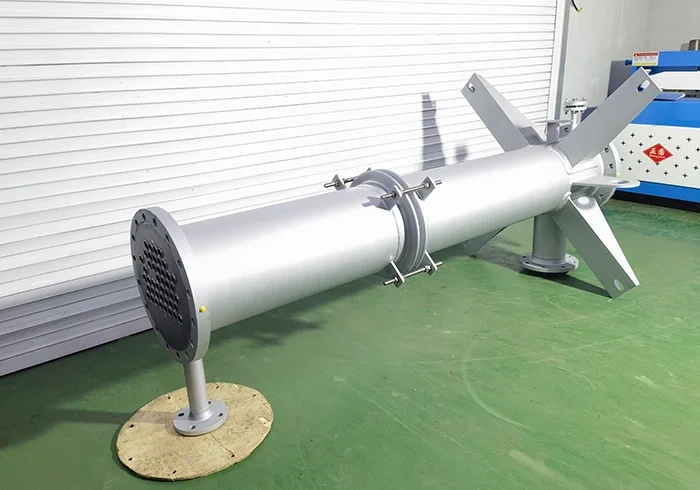In highly corrosive and thermally demanding industrial processes, traditional metal heat exchangers often fall short in longevity and performance. That's where tantalum heat exchangers stand out. Engineered from tantalum—a rare refractory metal known for its outstanding chemical stability and high-temperature resistance—these specialized heat exchangers are built to deliver exceptional thermal transfer while resisting the harshest acids, solvents, and oxidation environments. Whether used in the chemical, pharmaceutical, or metal processing industries, tantalum heat exchangers provide a highly reliable, maintenance-efficient solution for critical operations where material degradation is not an option.

What Makes Tantalum Heat Exchangers Different?
A tantalum heat exchanger is crafted from tantalum metal, a rare and highly durable material known for its superior resistance to corrosion, particularly in high-temperature and chemically aggressive environments. Tantalum's unique properties—such as its high melting point, excellent thermal conductivity, and exceptional resistance to oxidation and acid corrosion—make it the ideal choice for heat exchange systems that need to perform reliably under harsh conditions.
In industries like chemical manufacturing, pharmaceuticals, and metal processing, tantalum heat exchangers are crucial because they can withstand environments where other materials, such as stainless steel or copper, would quickly degrade. This ability to maintain structural integrity even in extreme conditions ensures that tantalum heat exchangers offer long-lasting and efficient performance.
Because of their remarkable resistance to corrosion and high heat tolerance, tantalum heat exchangers help prevent the frequent maintenance and replacement cycles that often come with traditional materials, ultimately reducing downtime and maintenance costs. Their ability to reliably transfer heat in demanding environments makes them indispensable for industries requiring consistent and durable heat exchange solutions.
How To Choose the Right Tantalum Heat Exchanger
When selecting a tantalum heat exchanger, it's essential to consider various factors to ensure the system meets the specific demands of your application. Choosing the right tantalum heat exchanger can improve efficiency, reduce downtime, and extend the lifespan of your equipment. Below are key considerations to guide your selection:
1. System Size and Capacity
The size and capacity of the tantalum heat exchanger should align with the volume of fluid being processed and the heat transfer requirements of your system. A properly sized heat exchanger ensures efficient operation, optimizing energy use while maintaining the desired temperature range. If the heat exchanger is too small, it may not provide sufficient heat transfer, while one that is too large could result in unnecessary costs and inefficiencies.
To determine the appropriate size, assess the fluid flow rate, pressure drop, and required heat transfer rate for your specific application. Ensuring the tantalum heat exchanger is appropriately sized will help maintain the optimal thermal performance and prevent overloading the system.
2. Fluid Types
Understanding the types of fluids involved in your system is crucial for selecting the right tantalum heat exchanger. Some tantalum heat exchangers are specifically engineered for handling highly corrosive acids, such as sulfuric or hydrochloric acid, while others may be better suited for more neutral fluids or industrial liquids.
It's important to consider the fluid's chemical composition, pH level, and viscosity when choosing a heat exchanger. Tantalum heat exchangers are ideal for environments where traditional materials would quickly deteriorate due to exposure to aggressive chemicals. Matching the tantalum heat exchanger to the specific fluid type will ensure long-term reliability and effective heat transfer.
3. Temperature Range
Different industrial applications require heat exchangers that can operate across various temperature ranges. Tantalum heat exchangers are versatile and can withstand both high and low temperatures, making them suitable for a wide array of processes. However, it's essential to match the tantalum heat exchanger's temperature range to the specific demands of your application.
For example, high-temperature processes, such as those in power generation or chemical processing, may require a tantalum heat exchanger that can endure extreme heat without degradation. Conversely, low-temperature applications, such as those in refrigeration or certain chemical processes, will require a tantalum heat exchanger that operates efficiently in lower temperature conditions. Selecting the right temperature range will ensure the tantalum heat exchanger provides optimal performance and avoids potential failure due to thermal stress.
Selecting the correct tantalum heat exchanger is not merely a technical decision—it's a strategic investment in the long-term efficiency and reliability of your operation. By factoring in system size, fluid compatibility, and temperature range, engineers and procurement professionals can ensure peak performance and reduced lifecycle costs. With its unmatched corrosion resistance, thermal durability, and mechanical integrity, tantalum continues to be the material of choice for high-stakes environments where performance cannot be compromised. Choosing the right configuration from the outset helps safeguard uptime, improve process consistency, and extend equipment longevity in the world’s most demanding applications.
https://www.tnztn.com/Tantalum-Heat-Exchanger
www.tnztn.com
Wuxi Qiwei Nonferrous Technology Co., Ltd.